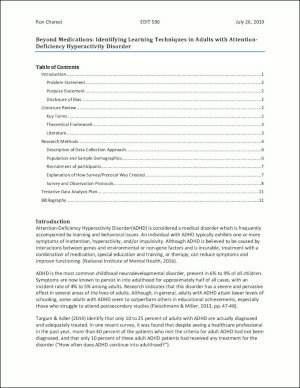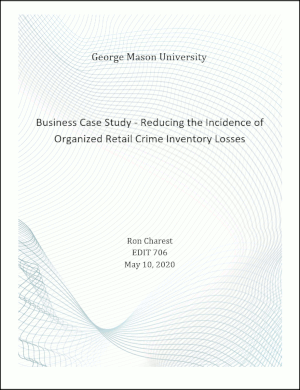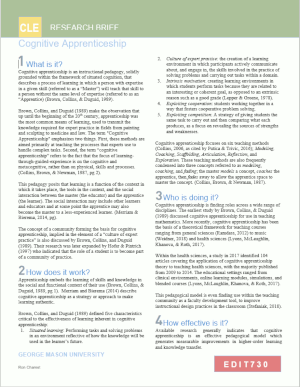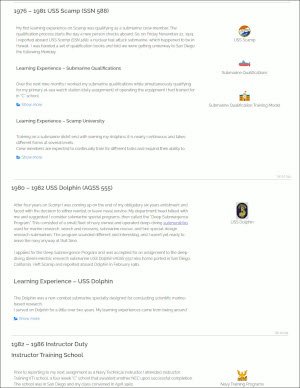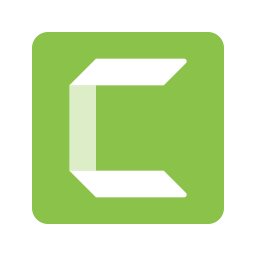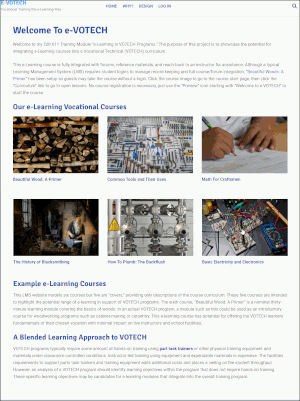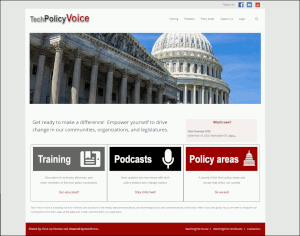My Graduate Portfolio
This is my portfolio collection of the major class projects that I worked on during my Instructional Design and Technology Masters in Education (MEd) program. I have included brief reflections on the course and project for each artifact. Overall, this graduate program was a transformational learning experience for me. I entered the program very self-conscious of my age as a student, with a checkered academic background, and limited self-confidence in my ability to make it through the program. I did succeed, however, and more than anything else gained a great deal of self-confidence in my academic abilities.
The purpose of education is to open the windows of the mind.
Debasish Mridha
Technical Writing
Research Proposal- EDIT 590
One of my individual projects was developing a research proposal written for the course “Educational Research in Technology.” We were assigned to individually select a topic, design a study, and write up a research proposal related to training. I opted for a proposal focused on identifying effective learning techniques in adults with Attention-Deficiency Hyperactivity Disorder (ADHD). This is an area of personal interest, and a subject I would like to pursue in the future should the opportunity arise.
Note: Citations are in APA 6th Edition format.
Business Case Study – EDIT 706
The semester assignment for EDIT 706, “Business of Learning Design and Technologies” was a business case study including an educational option as one of the proposed business solutions. I opted to model a fictional retail chain store, and proposed preventive solutions to a high incidence of organized shoplifting.
Although I had been working as a government consultant for ten years at the time of this course, I gained greater insight into my consulting practices as a result of this project. I realized, for example, that I had often attempted to offer my clients various training options without realizing this. Recognizing the concepts now allows me to offer more focused guidance to my clients.
Research Brief – EDIT 730
Our assignment was to write a research brief on a learning theory using the APA citations format. My selected topic was on Cognitive Apprenticeship, following my interest in vocational training. This paper is considered original research and was published in the MERLOT repository.
This research was confirmation of my personal education background. I recognized that most of my lifelong learning was through the cognitive apprenticeship model. During my Navy career I was both an apprentice and a master, sometimes simultaneously in different learning roles. In my post-Navy career, I recognized I was fortunate in that whenever I took on a new job I usually had a mentor who functioned as my master in a cognitive learning relationship.
Note: Citations are in APA 6th Edition format.
My Educational Autobiography – EDIT 704
This was my first significant graduate school writing assignment. The requirements were to present our educational life story in an engaging online presentation, including the social and historical context. Given I had almost sixty years of life story to present, my challenge was to present a narrative that kept my readers engaged. I developed an interactive website format that I have since used in other online technical writing projects.
This was a difficult and painful narrative, as my educational history has been difficult and painful. But it was a good exercise for me to reflect on my lifetime of learning. Since writing this paper, I’ve felt more grounded in my educational accomplishments, and more confident in taking on new challenges.
EDIT 705 – Designing A Training Program
My first team project was to create a training program for a selected topic. My group’s choice was a military transition (active duty to civilian) training program for Veteran Administration benefits. I had received this training over twenty years earlier when I retired from active duty, and working on this project brought back a lot of memories of my active-duty career.
This was a good re-entry into developing training programs, and my group worked together well. At the time I was feeling overwhelmed by taking this course simultaneously with EDIT 704, but my teammates provided the support I needed to work both courses. I came out of these two courses with a lot more confidence that I could complete my graduate program.
Presentations
Captivate – EDIT 575 DL1
My first interactive developmental project was working with Adobe Captivate to build a training lesson. I selected a Web 2.0 tool called “Preceden,” a timeline creation tool. I had a lot of fun working with this software, even though it was a steep learning curve. I felt exhilarated being able to express creativity in the design of my lesson.
Camtasia – EDIT 575 A01
This was my second interactive developmental project, this time working with the multimedia suite of tools called “Camtasia.” This software has a different focus than Captivate, but many similarities, and I felt I quickly picked up the needed skills. As with my Captivate project, the ability to express creativity in my lesson designs was exhilarating.
Storyboard – EDIT 576
My final course covered the use of mobile learning apps, and our main class project was to storyboard an app design. I chose a concept for a recreational fishing app that I had proposed in my earlier EDIT 704 course. This course gave me the opportunity to expand on my concept with a full storyboard layout I built using PowerPoint. I also built a Camtasia video presentation (included with this PowerPoint storyboard) that explains the use of this app, which is also included with the PowerPoint storyboard as artifacts.
This was yet another chance to exercise my creativity in the competency area of design and development. It was a fun project on several levels. Perhaps the most rewarding feedback I received in my peer reviews was the comment, “I’m not a fisherman, but if I had this app I’d start fishing.” This was the kind of visceral reaction I was hoping for in creating this app design.
Learning Management System – EDIT 611
This was my final three-credit course. Our individual semester project was to develop an e-Learning training module of no more than thirty minutes duration on a topic of our choice.
I chose to build a demonstration Learning Management System (LMS) for an e-Learning vocational training course. I feel passionate about adult vocational training and hope to work in this area after graduation. Building this LMS was another stretch for me in my web development abilities. Building this project also gave me a chance to reflect on just how much I’d learned in two years. Beyond educational theory, I realized I’d come a very long way in understanding website design, and understanding how to put together an organized training course.
I finished this project with a quiet sense of self-confidence that was completely opposite how I felt going into this graduate program just two years earlier.
UX Design
UX Design – EDIT 732 / EDIT 752
This was a two-course team project to conceptualize and design a prototype to learn UX (“User Experience”) concepts. The first course was the initial concept and wireframe, the second course was a more granular prototype and developing user testing. The course included working with a client to solve a real-world issue.
Our team’s client was a small non-profit working in telecommunications policy. We developed a prototype website to advance the client’s needs for training and to create a community of users focused on telecommunications policy. I finished these two classes with a deeper appreciation of UX design principles that has significantly advanced my own website design.
Web Accessibility – EDIT 726 001
This course covered web accessibility issues, an area I had never worked in before. The course project was to build a World-Wide Web Consortium (W3C) Web Content Accessibility Guidelines (WCAG) compliant website. The instructor provided specific design elements and the project had to meet all WCAG accessibility guidelines.
This course required hand-coding HTML and CSS, something I had not worked in for almost twenty years. Hand-coding was a good back-to-basics refresher for me, and following the design work of EDIT 752 added to my understanding of online media design. I also gained a deeper appreciation for the issues around Internet accessibility.
